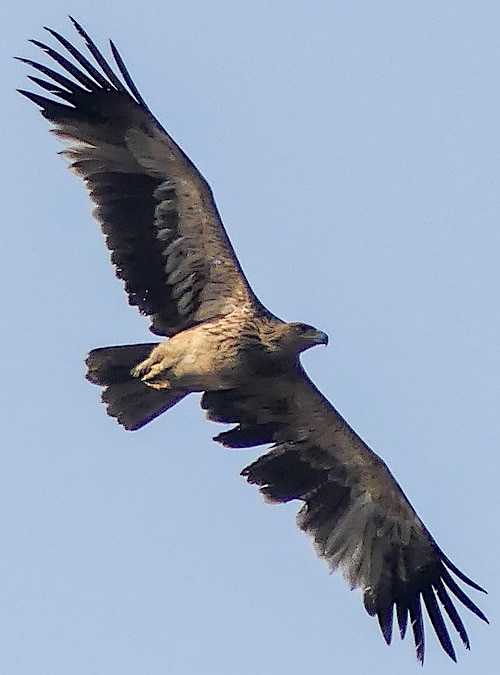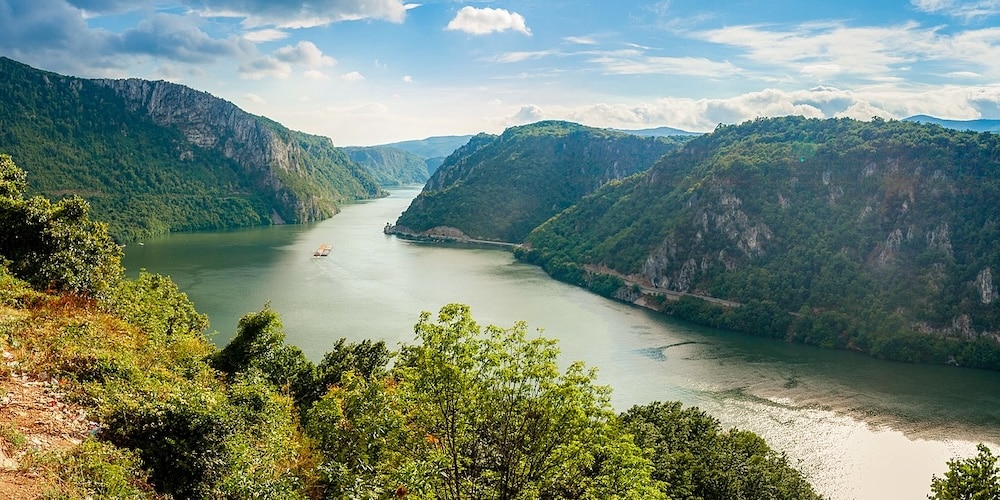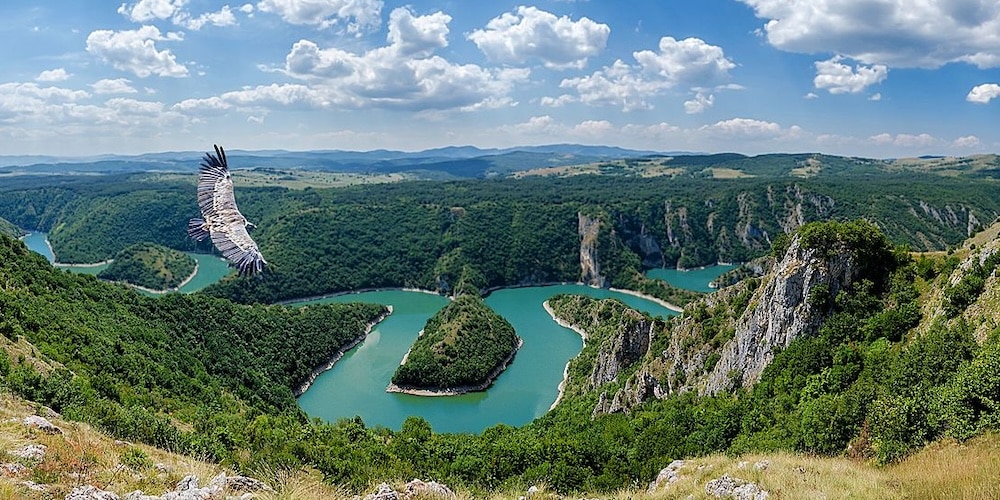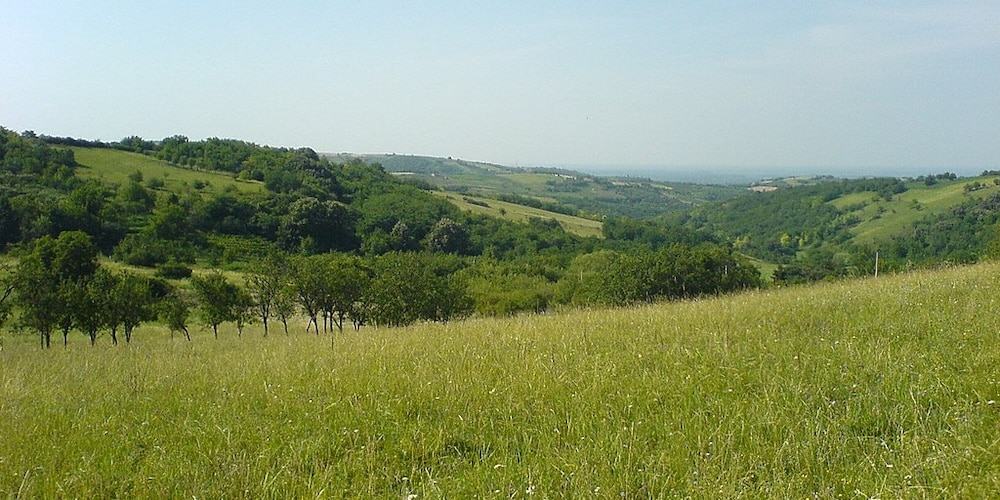Republic of Serbia

Serbia is a landlocked country in Southeast and Central Europe. Located in the Balkans, it borders Hungary to the north, Romania to the northeast, Bulgaria to the southeast, North Macedonia to the south, Croatia and Bosnia and Herzegovina to the west, and Montenegro to the southwest. Serbia claims a border with Albania through the disputed territory of Kosovo. Serbia has about 6.7 million inhabitants, excluding Kosovo’ over 1.4 million of whom live in Belgrade its capital and largest city. The country, not including Kosovo, covers an area of 77,474 km2 (29,913 square miles).
The Pannonian Plain covers the northern third of the country while the easternmost tip of Serbia extends into the Wallachian Plain. The terrain of the central part of the country consists chiefly of hills traversed by rivers. Mountains dominate the southern third of Serbia. Dinaric Alps stretch in the west and the southwest, following the flow of the rivers Drina and Ibar. The Carpathian Mountains and Balkan Mountains stretch in a north-south direction in eastern Serbia. Ancient mountains in the southeast corner of the country belong to the Rilo-Rhodope Mountain system. Elevation ranges from the Midžor peak of the Balkan Mountains at 7,116 feet (the highest peak in Serbia, excluding Kosovo) to the lowest point of just 56 feet near the Danube river at Prahovo. The largest lake is Đerdap Lake (163 km2) and the longest river passing through Serbia is the Danube, just over 587 kilometres long.

Ðerdap National Park – Milan ©Paunović CC BY-SA 4.0 via Wikimedia Commons
Almost all of Serbia’s rivers drain to the Black Sea, by way of the Danube river. The Danube, the second largest European river, represents the major source of fresh water. It is joined by its biggest tributaries, the Great Morava (longest river entirely in Serbia at 493 km long), Sava and Tisza rivers. One notable exception is the Pčinja which flows into the Aegean. Drina river forms the natural border between Bosnia and Herzegovina and Serbia. Due to configuration of the terrain, natural lakes are sparse and small; most of them are located in the lowlands of Vojvodina, like the aeolian lake Palić or numerous oxbow lakes along river flows (like Zasavica and Carska Bara). However, there are numerous artificial lakes, mostly due to hydroelectric dams, the biggest being Đerdap (Iron Gates) on the Danube, Perućac on the Drina, and Vlasina. The largest waterfall, Jelovarnik, located in Kopaonik.

Uvac River – ©Sasapokimica CC BY-SA 4.0 via Wikimedia Commons
The climate of Serbia is under the influences of the landmass of Eurasia and the Atlantic Ocean and Mediterranean Sea. With mean January temperatures around 0 °C and mean July temperatures of 22 °C, it can be classified as a warm-humid continental or humid subtropical climate. In the north, the climate is more continental, with cold winters, and hot, humid summers along with well-distributed rainfall patterns. In the south, summers and autumns are drier, and winters are relatively cold, with heavy inland snowfall in the mountains. Differences in elevation, proximity to the Adriatic Sea and large river basins, as well as exposure to the winds account for climate variations. Southern Serbia is subject to Mediterranean influences. The Dinaric Alps and other mountain ranges contribute to the cooling of most of the warm air masses. Winters are quite harsh in the Pešter plateau, because of the mountains which encircle it. One of the climatic features of Serbia is Košava, a cold and very squally southeastern wind which starts in the Carpathian Mountains and follows the Danube northwest through the Iron Gate where it gains a jet effect and continues to Belgrade and can spread as far south as Niš.
Birding Serbia
Serbia is a country of rich ecosystem and species diversity; covering under 2% of Europe, Serbia is home to 39% of European vascular flora, 51% of European fish, 40% of European reptiles & amphibians, 74% of European birds and 67% of European mammals. Its abundance of mountains and rivers make it an ideal environment for a variety of animals, many of which are protected including wolves, lynx and bears. There are 17 snake species living all over the country; 8 of them are venomous. Some iconic bird species can be found. For example, Uvac Gorge is considered one of the best habitats for Griffon Vulture in Europe. In area around the city of Kikinda, in the north of the country, is the world’s largest know roost of 145 Long-eared Owls.
There are around 380 protected areas of Serbia, encompassing almost 7% of the country. Those protected areas include national parks such as Đerdap, and Fruška Gora, nature parks and more than 60 nature reserves. Around 30% of the country is covered by forest (25,625 km2), with the proportion of conifers being only 10%; the most common species being oak and beech.

Fruska Gora National Park – ©I Pokrajac CC BY-SA 3.0 via Wikimedia Commons
Thus, in terms of biodiversity, the Balkan Peninsula is recognised as one of Europe’s finest birding regions. Within it, Serbia compares well with already established birding destinations like neighbouring Hungary or Bulgaria, as it has a greater diversity of habitats and birds than Hungary and a better infrastructure than Bulgaria. Reasonably good (and improving) accommodation is available near birding sites and, with the return of political stability, the country is poised to provide the traveller with an exciting birding experience.
Bird Numbers – The number of bird species recorded in Serbia is 388 species. In recent years, around 240 bird species were recorded as breeding in Serbia, quite a few of them increasing their breeding ranges: Black-headed Bunting, Cetti’s Warbler, Red-rumped Swallow, Black Redstart, etc. Significant percentages of European populations of Saker Falcon, Little Bittern, Purple Heron, Ferruginous Duck, Scops Owl, Middle Spotted and Syrian Woodpeckers, to mention but a few, breed in Serbia. Among them are 103 species of European conservation concern (SPECs), which include six species of global conservation concern: Ferruginous Duck, Egyptian Vulture, Imperial Eagle, Lesser Kestrel, Great Bustard and Corncrake. Interestingly, while they were not yet recorded in Serbia in the breeding season, Masked Shrike, Olive-tree Warbler and Sardinian Warbler were seen breeding just south of the border and it is not unlikely that some pairs might choose localities further north.
Regions – North of Belgrade, the Pannonian plain is a lowland landscape with large rivers (Danube, Sava and Tisa), and to the south, hilly/mountainous landscapes are intersected by river valleys. Forest covers 27% of Serbia (25,625 km2), with the proportion of conifers being only 10%.

Beljarica Wetland – ©Jsphotomorgana, CC BY-SA 4.0 via Wikimedia Commons
When to go – Sun can be formidable: don’t forget a wide-brimmed hat, water bottle and sunscreen cream. For wetland areas, insect repellent is also heartily recommended. An early start to any birding day is essential – mid-day summer temperatures often climb well into the thirties. Depending on your particular interest, opt for March/April (spring migration), May to July (breeding season), August to October (autumn migration and occasional vagrants), November/December when water bird migration reaches its peak, or January/February period when more than 250,000 water birds overwinter on the lower Danube.
Logistics – As Serbia is not a large country (only marginally smaller than Portugal, Hungary or the US state of Indiana) and the infrastructure is fairly well developed, it is possible to explore it in about dozen days and, with some advance planning and guidance from the local experts, build up a list of more than 150 species. Bear in mind that the local experts are concentrated in Belgrade and north of it and harder to find further south. Among travel guides, due to its extensive coverage of natural history and birding sites, recommendation goes to Laurence Mitchell’s Serbia: The Bradt Travel Guide. The time has come for Serbia to be appreciated as another excellent birding destination in the Balkans.
-
Belgrade Area
Confluence of the Sava and the Danube Rivers: (together with the river branches, ponds, willow and poplar forests of the Danube floodzone, along the northern bank, some dozen kilometres up and downstream), is surprisingly rich in birdlife. Local bird list is some 210 species long, about 100 of them breeding in the area. Another important breeding area is the neighbouring fish farm "Mika Alas" in the suburb of Krnja?a (reachable by buses No. 95 and 96; leave the bus at Sebe -
Northern Plains
Carska Bara Near Zrenjanin, Carska Bara is renowned for its variety of birdlife, with over 260 species recorded. Among reserve -
Southern Gorges
Djerdap Gorge Situated in north-east Serbia along the border with Romania and about 6 km in width by some 100 km in length, this national park covers a section of the river Danube gorge and adjacent belt of 768 m a.s.l. high Miroc mountain. Deciduous forest and scrub cover some 70% of the park, the rest are grassland, streams and limestone cliffs. Birds of the area include Black Stork, Honey Buzzard, Black Kite, Golden Eagle, Lesser Spotted Eagle, Booted Eagle, Peregrine Falcon, Hazel Grouse, Rock Partridge, Corncrake, Stock Dove, Eagle Owl, Alpine Swift, Sombre Tit, Ortolan Bunting. The added attraction of the park is the presence of large mammals such as chamoa, brown bear and lynx. For non-birding members of a group, there are well preserved mediaeveal fortresses Golubac and Fetislam as well as the Lepenski Vir, eight millenia old Neolithic settlement famous upon its fish-like human head stone sculptures -
Southern Mountains
Mt. Kopaonik The largest and highest (2016 m a.s.l.) mountain of central Serbia and oversized winter sports centre. In the Ravni Kopaonik area coniferous forest (spruce) predominates, with a small area covered by alpine vegetation. Birds to look for are Honey Buzzard, Short-toed Eagle, Golden Eagle, Peregrine Falcon, Rock Partridge, Corncrake, Woodcock, Tengmalm
-
Dragan Simic
| birdingserbia@gmail.com
BLOG -
Slobodan Puzovic
Ornithologist | spuzovic@ns.sbb.co.yu
-
Number of bird species: 388
(As at April 2025)
-
Avibase
PDF ChecklistThis checklist includes all bird species found in Serbia , based on the best information available at this time. It is based on a wide variety of sources that I collated over many years. I am pleased to offer these checklists as a service to birdwatchers. If you find any error, please do not hesitate to report them. -
E-Bird
PDF ChecklistThis checklist is generated with data from eBird (ebird.org), a global database of bird sightings from birders like you. If you enjoy this checklist, please consider contributing your sightings to eBird. It is 100% free to take part, and your observations will help support birders, researchers, and conservationists worldwide. -
Wikipedia
Annotated ListThis is a list of the bird species recorded in Serbia. The avifauna of Serbia include a total of 388 species, one of which has been introduced by humans.
-
Birds of Europe, North Africa, and the Middle East
| Photographic Guide | By Frédéric Jiguet & Aurélien Audevard | PUP | 2017 | Paperback | 447 pages, 2200 colour photos, colour distribution maps | ISBN: 9780691172439 Buy this book from NHBS.com -
Birds of Serbia: Critical List of Species
| By Marko Šćiban, Draženko Rajković, Dimitrije Radišić, Voislav Vasić & Uroš Pantović | Bird Protection & Study Society of Serbia | 2015 | Paperback | 194 pages, no illustrations | Text Serbian & English | ISBN: 9788691519964 Buy this book from NHBS.com -
Collins Bird Guide
| By Lars Svensson | Harper Collins | Edition 3 | 2023 | Paperback | 478 pages, 4000+ colour illustrations, 700 colour distribution maps | ISBN: 9780008547462 Buy this book from NHBS.com -
Where to Watch Birds in Europe and Russia
| By Nigel Wheatley | Princeton University Press | 2000 | Paperback | 432 pages | Out of Print | ISBN: 9780713648706 Buy this book from NHBS.com

Collins Bird Guide
AndroidThe Collins Bird Guide App provides everything you need to identify a species quickly and learn about it thoroughly.
Collins Bird Guide
Apple iOS |Collins Bird Guide 4+ A field guide to Europe NatureGuides Ltd. Designed for iPadMuseums & Universities-
Belgrade Natural History Museum
WebsiteFounded on December 19, 1895, it is one of the oldest specialised scientific institutions set up in Serbia. Rich tradition of studies of Gea, Botany and Zoology
Organisations-
Birds Protection and Study Society of Vojvodina
WebsiteBird Protection and Study Society of Serbia (BPSSS) was established on November 18th 1989 as Bird Protection and Study Society of Vojvodina. . Society was founded as a result of activities of the Commission for Study and Protection of Birds of The Society of Ecologists of Vojvodina, which gathered professional and amateur ornithologists mainly from the territory of Serbian Province of Vojvodina. Initially, the activities of the Bird Protection and Study Society of Serbia involved issuing of journal and annual gatherings of its members. Decision on change of name of Society, in line with its dedicated work in the whole territory of Serbia and strategic way towards establishing the partnership with BirdLife International, was adopted on eargy General Assembly on 18 December 2010 by majority of voices of members. Statute of the Society was also changed, in line with current rlegislative regulating organizing of civil society. Society was registered in Registry of Association within Serbian Bussines Agency Register under the new name on 12. May 2011. -
Birds of Prey Protection Fund
WebsiteBirds of Prey Protection Fund is dedicated to the conservation of diurnal and nocturnal raptors in Serbia. The most significant project undertaken by the BPPF was Save the Griffon Vulture Campaign which increased dwindling population of this species up to the biggest flock in the central Balkans. Write to the Fond za zastitu ptica grabljivica, Despota Stefana 142, 11000 Belgrade, Serbia; e-mail: grifon@ibiss.bg.ac.yu -
Institute for Protection of Nature of Serbia
InformationInstitute for Nature Conservation of Serbia is a professional institution that carries out activities on protection and improvement of the natural heritage of Serbia. The Institute was founded on April 30th 1948 as the Institute for Protection and Scientific Research in Natural Rarities of the People's Republic of Serbia. -
League for Ornithological Action (LOA)
Facebook PageThe goal of the League for Ornithological Action (LOA) is protecting the birds through the preservation of their species, habitats and sites through the involvement of people. Belgrade group has monthly evening meetings at the Institute for Protection of Nature of Serbia featuring talks and slide shows, while bird walks take place in and around Belgrade. Membership fee includes a free copy of quarterly pdf newsletter Dvogled (The Binoculars, with short English summaries). For information, please write to: Goran Sekulic, Secretary, Liga za ornitolosku akciju, Dr. Ivana Ribara 91, 11070 Belgrade, Serbia; or loa@ptica.org . See also
Reserves-
*Protected Areas of Serbia
InformationSatellite ViewInteractive linksm to Nztional Parks, Nature Reserves etc... -
BR Golija
InformationSatellite ViewGolija is a mountain in southwestern Serbia, between towns of Ivanjica and Novi Pazar. It is part of the Dinaric mountain range. The mountain is heavily forested with significant biodiversity. -
NP Fruška Gora
InformationSatellite ViewFruska Gora is an isolated, narrow, island mountain in Pannonia plain. It is intended by river courses extending to the south and north, with some side ranges with steep slopes, spreading from the main narrow range. Its location, specific geological history and different microclimatic conditions make it very interesting and important to science. Park is home to 211 bird species. Symbol of Fruška Gora is eastern imperial eagle, today with only 2 or 3 remaining breeding couples. There are 60 mammalian species, of which 17 are protected, including edible dormouse, European pine marten, European polecat and Mediterranean water shrew.[2] Out of 30 species of bats which live in Serbia, 15 inhabits the mountain and all are under strict protection. In January 2018, for the first time after the 1960s, additional mouflons were introduced in the park. 30 animals were relocated from Slovakia, which raised the number of mouflons in the park to 70 -
NP Kopaonik
InformationSatellite ViewSituated in the central part of Serbia, the Kopaonik National Park with its 11810 hectares encompasses the highest parts of this mountain range marked by the valleys of the rivers of Ibar, Jošanica, Toplica and Brzeæa reka… -
NP Tara
InformationSatellite ViewTara is a mountain located in western Serbia. It is part of Dinaric Alps and stands at 1,000 to 1,590 m (3,280 to 5,220 ft) above sea level. The mountain's slopes are clad in dense forests with numerous high-altitude clearings and meadows, steep cliffs, deep ravines carved by the nearby Drina River and many karst, or limestone caves. 135 bird species make their temporary or permanent homes on the slopes of the mountain, including golden eagle, griffon vulture, peregrine falcon, Eurasian eagle owl and black grouse. On Perućac lake on the Drina, there is a population of common merganser, with 50 pairs. Tara has 53 mammals including the protected brown bear and otter, as well as chamois, roe deer, lynx, wolf, jackal, wild boar and marten. -
NP Đerdap
InformationSatellite ViewThe Djerdap National Park embraces part of the area of the Djerdap Canyon known as the Iron Gates in the central part of the Danube river course,and is divided by the international border running along the middle of the river into the southern - Yugoslav and the northern - Rumanian part. The total area of the National Park is 63.600 ha and the protection zone consists of another 93.968 ha. The park is also a home to 150 bird species. -
NR Carska Bara
InformationSatellite ViewCarska Bara is the best known for its abundant bird life and the first ornithological exploration began in the late 19th century. There are 240 bird species in the area. There are colonies of herons (grey heron, little egret) and cormorants (including pygmy cormorant), and other species include buzzards, Eurasian sparrowhawks, common spoonbills, western marsh harrier, Montagu's harrier, red-breasted goose, osprey, stork, woodcock etc. Some 110 bird species are migratory. -
NR Deliblatska Peščara
InformationSatellite ViewDeliblato Sands is a large sandy area covering around 300 km² in Vojvodina province. It is located in southern Banat, situated between the river Danube and the southwestern slopes of the Carpathian Mountains. The area is rich in floral diversity. Rare fauna include the mole rat, steppe polecat, desert ant and steppe gerbil. The main source of food for some endangered birds of prey, such as the saker falcon, eastern imperial eagle and lesser spotted eagle, are ground squirrels that live in large open fields. Other noted animals are the wolf, deer, roe deer and boar. -
NR Gornje Podunavlje
InformationSatellite Viewis a large protected area of wetland in the northwest of Serbia (Vojvodina province), on the Danube's left bank. It comprises two large marshes, Monoštorski Rit and Apatinski Rit and vast forests, meadows, ponds, swamps and the Danube's meanders. The area is home to some important species such as white-tailed eagle (Haliaeetus albicilla) or black stork (Ciconia nigra), but also to ferruginous duck and Eurasian spoonbill. A total of 248 species of birds live in the reserve, or 71% of all bird species in Serbia (349). -
NR Uvac
InformationSatellite ViewUvac Special Nature Reserve is a category 1 reserve. It is known for the successful project ensuring the preservation of griffon vultures. The main attraction in the reserve is the avifauna, with 172 bird species. -
NR WII Obedska bara
InformationSatellite ViewObedska bara is a large swamp-forest area and natural reserve stretching along the Sava River in Southern Syrmia, some 40 km west of Belgrade. The pond is an oxbow lake, a remnant of the meanders of the old Sava River, whose main stream presently flows more southward. It is home to around 220 species of birds. -
WeRv WII IBA Zasavica
InformationSatellite ViewZasavica is a bog in the region of Mačva, west-central Serbia. With Obedska bara and Carska Bara one of the major wildlife refuges and one of the last authentically preserved wetlands in Serbia. In the 2000s became a popular attraction with the successful reintroduction of the beavers, which had become extinct 100 years ago. There are 185 species of birds in the reservation, of which 120 are resident. Because of such a large number of birds, including rarities like night heron and spotted crake, Zasavica is included in the list of IBAs. Since 1998, 20 artificial nesting platforms have been placed throughout the reserve. Other species include great reed warbler, little bittern, common quail, white stork, black stork, Eurasian bittern, white-tailed eagle, western marsh harrier, etc. -
Wetlands
WebpageSatellite ViewThe convention entered into force in Serbia on 27 April 1992. Serbia currently has 10 sites designated as Wetlands of International Importance (Ramsar Sites), with a surface area of 63,919 hectares.
Sightings, News & Forums-
eBird
SightingsBirding This Month
Guides & Tour Operators-
Belgrade Private Tours
Local ExcursionsJoin our bird expert on a small expedition through the captivating nature that surrounds Belgrade. -
Birds, Wildlife & Nature
Tour OperatorPlease note that Serbia has rapidly become one of the most talked about birding destinations in Eastern Europe. Why? Firstly because of David Lindo and Milan Ružić who have done wonders promoting this fabulous destination -
Birdwatch Serbia
Local Tour OperatorBirdwatching tours We offer a great variety of bird watching tours in Serbia -
Paul Miguel Photography
Tour OperatorBird Photography Tour Serbia -
SakerTours
Tour Operator -
SerbiaDMC
Local Tour Operator -
Wild Echotours
Tour OperatorWalk through the national parks and reserves of Serbia and explore the wildlife they offer.
Trip Reports-
2004 [08 August] - Mike Unwin
PDF ReportThis is a report on a nine-day guided bird-watching tour of Serbia on behalf of Birdwatch magazine by Mike Unwin -
2022 [01 January] - Gina Nichol
PDF ReportA Red Squirrel greeted us as we entered Kalemegdan Park. We slowly walked along and ticked our first official birds of the trip: Common Wood-Pigeons, Coal Tit, Eurasian Blue Tit, a number of Great Tits, Hooded Crow, Common Chaffinch, and Black Redstart. Excitement ensued when, all at once, a pair of Hawfinches landed in trees nearby offering great views -
2023 [06 June] - Paul Miguel
ReportThe next morning we had our first photo session – a beautiful setting for Hoopoe. Both parents were bringing food back to the chicks – my clients worked largely on capturing flight shots whilst I concentrated on video. -
2023 [12 December] - Paul Miguel
ReportThe Long eared Owl Winter Tour was a successful trip. Lots of Owls (there always is!), Serbian hospitality and some wonderful food! We also saw plenty of Buzzards, a flock of Common Cranes...
Blogs-
Dragan Simic
BLOGDragan Simic is obsessively passionate about two things – birding and travelling in search of birds, and that has taken him from his native Balkans to the far shores of Europe and the Mediterranean, southern Africa, India and Central America. -
Dragan Simic - Dragan's Birding Tips
BLOGHighly Commended in the 2015 BBC @WildlifeMag Blogger Awards; writer, birder, guide, ecotourism consultant, environmental scientist, conservation campaigner -
Dragan Simic - Dvogled I Veslo (Binoculars and Oars)
BLOGAlbicilla Belgrade, Serbia, naturalist, author, editor, translator… Beside birds and traveling in search of them, I like a good beer and the croaky voice of Shane MacGowan, hate confinements of four walls, but prefer four wheels and a lot of elbow room around. Birder by passion and environmental scientist by education, I am an ecotourism consultant, a field researcher and a bird blogger who always thinks that birding must be better behind that next bend in the road, and that the best bird ever is – the next lifer.
Fatbirder - linking birders worldwide...
Skip to content
